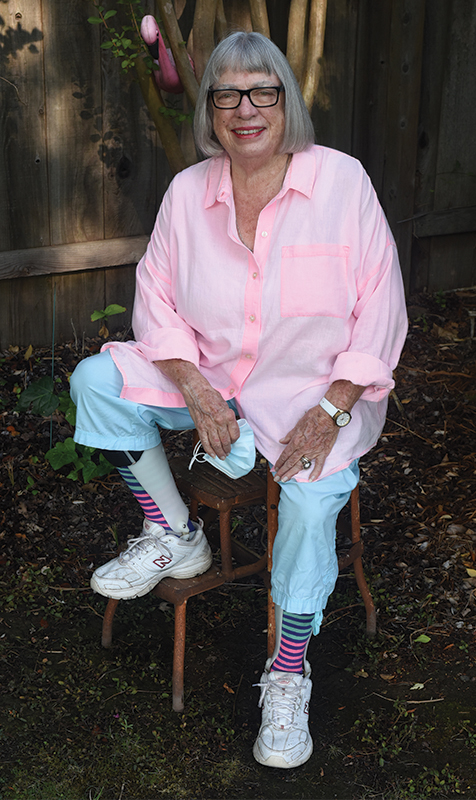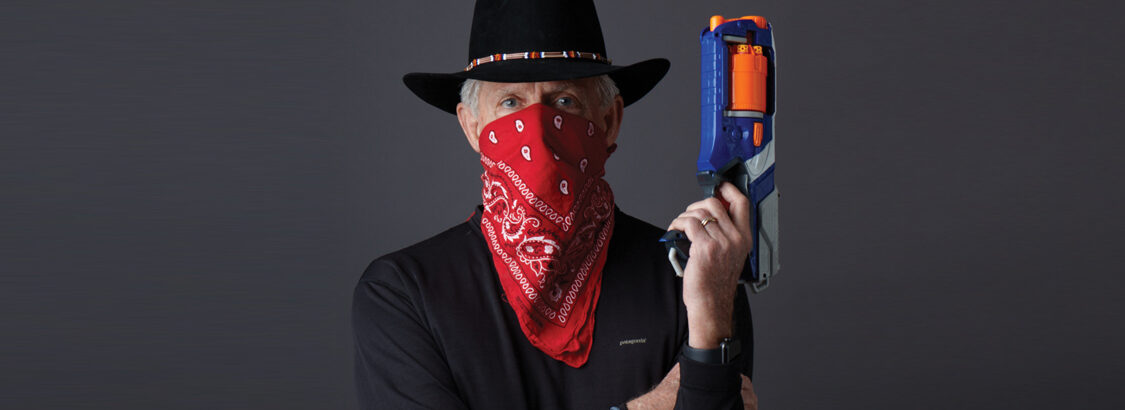Several years ago, in a simpler time and place, I had issues with my next door neighbor, Bobby.
We were both highly competitive, and it finally boiled over into violence. We each had guns—six-shot revolvers like the Lone Ranger’s famous Colt—and we had it out, quick-draw fashion, on the small front lawn that connected our homes.
What makes this story relevant today, is the fact that I wore a red bandana over my face when I drew on Bobby and shot him square in the chest.
He staggered backward, dropping his gun and clutching his heart while gasping, “Oh my God, I’m shot.”
He then crumpled slowly to the ground, twitched several times and was still.
It was all a little melodramatic, I thought, as I walked over, pulled down my bandana and poked him tentatively in the back with the toe of my cowboy boot.
He giggled, breaking the spell, but refused to stop being dead until I toed him again, harder.
I won a lot of gunfights back then, and that red bandana was a frequent part of my wardrobe.
All of which had mostly faded from memory until I recently began wearing a bandana again — or more precisely, an N95 mask.
Like the bandana, the N95 mask feels a little claustrophobic to me, especially when I have to wear reading glasses to make out the keypad numbers in the Sonoma Valley Market credit card reader as the lenses fog from my redirected breath.
That never happened when I used to shoot Bobby, because I didn’t need glasses back then — I just aimed for his chest. But the familiarity of the fabric over more than half my face is an instant flashback to that childhood when, coincidentally, another pandemic was running its course, one I was only dimly aware of in my gunslinging days, and which mainly impinged on my freedom to use a public swimming pool each summer.
I didn’t know until adulthood that polio was a big deal, that it terrified parents across the country, including mine, and that the least likely but most feared consequences of contracting the disease was being consigned for months or years (or a lifetime) to an iron lung. That term by itself was paralyzing, as were the newspaper images of both children and adults encased in metal cylinders with just their heads emerging, while a pressure pump forced their chests to expand and contract.
Unlike COVID-19, which attacks the lungs directly, the poliomyelitis virus attacks nerve cells in the spinal cord, which results in loss of muscle function and paralysis.
Kathleen Hill, Sonoma’s resident culinary journalist, radio host and multiple author, grew up during that time, contracted the disease as a child, and still suffers the neurological consequences every time she walks, stands or even sits.
As a competitive swimmer with numerous age-group breaststroke records, Hill spent hours in the pool at the Berkeley City Club, when something went radically wrong with her body, twice.
Severe pain in her legs drove her out of the pool and out of school, which led to a year-long stay in bed.
She eventually recovered enough to get back to school and competitive swimming, but the disease wasn’t done with her.
“I remember crying while I was swimming because my coach kept yelling at me to kick my legs harder, and my brain was telling me I was. I thought I was, but it turns out I wasn’t.” Her legs refused to follow her commands.
Then, during a weekend swimming meet, she says, “My mother said my neck turned purplish. They got five UC football doctors, who came up with the diagnosis of rheumatic fever and a heart murmur. They said I had to quit swimming.”
The diagnosis was wrong, and later famed epidemiologist Larry Brilliant corrected it. Hill says Brilliant, who now chairs the board of a group called Ending Pandemics, told her, “You didn’t have rheumatic fever, you had more polio.”
The disease left both a physical and emotional imprint on Hill’s life.
Polio, in the 1940s and 50s was only referred to as an epidemic, not a pandemic.
“My life was different from other kids. There was the stigma of being out of school for a year. And I hurt so much. I remember people thinking of me as a little different, and distanced.”
Polio notwithstanding, Kathleen Hill recovered to lead a full, rich and productive life, partnering with husband Jerry to raise four children, manage several notable political campaigns and write more than 30 books, among many other things.
According to news reports, says Hill, “post-polio people are always in a hurry to get things done. People often ask me why I do so much, why I don’t slow down.” It’s a question that Hill, now in her 70s, has barely considered.
But despite a very busy and productive life, about 20 years ago Kathleen Hill’s pain returned. “I had pain memories,” she explains. “I was infected mainly in my legs and my hands. And 15 or 20 years ago I began feeling the pain again. All of a sudden I had the same pain in my right leg that I recognized from childhood.”
What was happening to Hill is known as post-polio syndrome, which mimics some of the symptoms from the initial infection and is believed to be a result of neuron fatigue when nerve cells, that have regenerated motor neurons to compensate for the damage done by the virus, become overwhelmed by muscle demands.

Which presents, says Hill, an ironic dilemma. “If you exercise,” she explains, “the neurons wear out faster. So you’re caught between exercising more and wearing them out, or not exercising and having the muscles atrophy.”
Hill has been wearing leg braces for many years now to compensate for muscle weakness. “I started with one leg brace on my right leg. Then I ended up with two. It’s a blessing. They keep me from falling down.”
She says she feels significant pain when she walks, but still tries to go for a walk very day, although COVID-19 has changed the mobility equation.
“Yes. I’m scared,” she admits. “It makes us all more vulnerable to other things, which is why I’m staying at home now. If we don’t follow the rules, we’re exposing ourselves more.”
Polio, in the 1940s and 50s was only referred to as an epidemic, not a pandemic. But for parents in the first half of the last century, it was a terrifying, life-changing plague.
In 1952, three years before Jonas Salk perfected the vaccine that would virtually eradicate the disease, close to 58,000 polio cases were reported in the U.S., with varying degrees of paralysis in more than 21,000 victims, and some 3,000 deaths. That’s a mortality rate of about 5 percent, significantly higher than the current U.S. COVID-19 mortality rate of about 1.9 percent.
But COVID-19 has proven to be vastly more infectious, largely because of its airborne transmission, and is currently known to have infected something over 4 percent of the U.S. population. Nonetheless, as many as 15,000 cases of polio-related paralysis occurred for several years in the 1940s and 1950s, making it the most feared disease in North America.
It was considered a summertime disease, because that’s when the most infections occurred, which resulted in the closure of swimming pools and movie theaters, with public health officials urging people to space themselves apart in large gatherings. Then as now there was widespread resistance to efforts at closing large gatherings and a widespread fear that public vigilance would hurt the economy.
Wytheville, Virginia, in 1950, had a polio outbreak that became one of the worst per capita epidemics in U.S. history. Nearly 200 people in and around the town of 5,500, developed confirmed cases of polio. Local records say 23 people died, mostly children, equaling better than a 10 percent fatality rate.
That summer, stores, churches and theaters closed, while highway signs warned visitors to pass on by. No surprise, the illness fell hardest on the community’s minority Black population because, in the still-segregated South, Black patients were not accepted at all-white hospitals. Panicked Black parents with infected children were shunted 250 miles away to a Black hospital when white-only hospitals much closer refused to accept them.
Today, a similar disparity exists in the fact that nearly 70 percent of Sonoma County COVID infections are in Latinos, who make up just over 27 percent of the county population. That disparity does not suggest overt racism so much as the absence of affordable housing and access to medical care.
Clearly, the more things change, the more they sometimes seem to stay the same.

